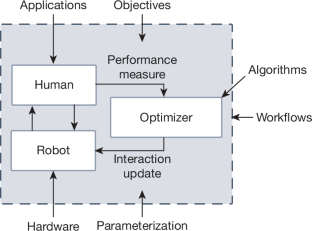2024-10-11 ハーバード大学
<関連情報>
- https://seas.harvard.edu/news/2024/10/keeping-humans-loop-robotic-design
- https://www.nature.com/articles/s41586-024-07697-2
人間とロボットの相互作用の最適化について On human-in-the-loop optimization of human–robot interaction
Patrick Slade,Christopher Atkeson,J. Maxwell Donelan,Han Houdijk,Kimberly A. Ingraham,Myunghee Kim,Kyoungchul Kong,Katherine L. Poggensee,Robert Riener,Martin Steinert,Juanjuan Zhang & Steven H. Collins
Nature Published:25 September 2024
DOI:https://doi.org/10.1038/s41586-024-07697-2

Abstract
From industrial exoskeletons to implantable medical devices, robots that interact closely with people are poised to improve every aspect of our lives. Yet designing these systems is very challenging; humans are incredibly complex and, in many cases, we respond to robotic devices in ways that cannot be modelled or predicted with sufficient accuracy. A new approach, human-in-the-loop optimization, can overcome these challenges by systematically and empirically identifying the device characteristics that result in the best objective performance for a specific user and application. This approach has enabled substantial improvements in human–robot performance in research settings and has the potential to speed development and enhance products. In this Perspective, we describe methods for applying human-in-the-loop optimization to new human–robot interaction problems, addressing each key decision in a variety of contexts. We also identify opportunities to develop new optimization techniques and answer underlying scientific questions. We anticipate that our readers will advance human-in-the-loop optimization and use it to design robotic devices that truly enhance the human experience.



